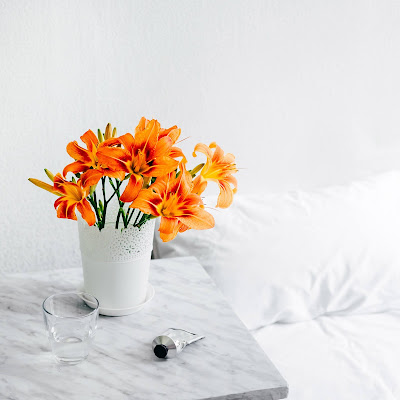According to the Interaction Design Foundation "White space is the area between design elements. It is also the space within individual design elements, including the space between typography glyphs (readable characters).”
Editor’s note: This blog is a guest post by
Catherine Agopcan
“White space” is NOT blank space. When we remove that stack of magazines or put away our unfinished art project supplies, our actions create an opening for those things, people, and activities that are meaningful to us.
As we work through any clean-up effort, we can tap into the comfort
element of the color white.
In Christianity, white is a symbol of birth, beginnings, and communion.
In Western culture, brides wear white as a sign of purity. White signifies clean lines, clear energy, and spaciousness.
We need not fear “white space” as being empty. It clears and lightens the way as we check out the “white space” ideas below.
Keep the Calendar Empty
It’s easy to fill our days with to-do lists and commitments we
aren’t excited about. Instead of saying yes to all invitations, consider
blocking out time to do nothing.
Our current mindset may tell us we need to be doing something or
consuming something at all times.
Pause to consider ways to use the peaceful energy of “white space” into each day.
The big thing is to put our phone down, turn off the TV, and just sit with our thoughts.
If we find it relaxing, we may use this free time to meditate, journal, walk around
the block or do something with our hands.
In a world where our attention is a commodity, reserving down time to reconnect is key to our sense of well-being.
Curate Our Home
Our homes are not storage spaces. They are places to enjoy alone time and be with the people that matter.
Many of us are on auto-pilot, buying more things to organize our home. If we look through what we already have and review what is or is not useful, we are ahead of the game.
A constant barrage of things to see, and lack of “white space”
means our minds are processing information that is not relevant to our daily
goals.
If our home environment doesn't make us feel serene, we can look around to see what can be downsized or eliminated and gain white space.
Sort out junk from kitchen or bathroom cabinets and donate excess. Put things that serve a purpose into white or clear containers with simple labels.
In our gusto for streamlining, we may go overboard. We need to find balance, and deal mindfully with one thing at a time.
While our homes aren’t meant to be museums, we can be discerning. One way to do that is to save only those objects that look good together.
One simple, inexpensive way to freshen things up is to consider changing the wall paint color to a white for a quick transformational fix.
Embrace White Objects
Use a white cloth table covering and that meal will feel special.
Serve food on a white dinner plate and notice how delicious it looks.
Choose white hotel sheets and the bed will look inviting.
Put out the white towels to make guests feel welcome.
Wear a crisp white shirt and colorful accessories to stand out and look distinctive.
Our customary habit may be to forgo using white objects,
because of the potential care they require.
Remember our things need to be handled mindfully, and we deserve beautiful things. By limiting our possessions to treasured items, we'll make those we keep shine against
a white backdrop.
 |
Photo by Alexandra Gorn onUnsplash
Let’s visualize ourselves in the New Year, and imagine easily releasing excess possessions, habits, attitudes, and activities that no longer bring value
to daily living.
Use the color white to help make bolder
choices that will have deep impact throughout the year and beyond.
Catherine
Agopcan is a financial educator and sustainability advocate educating others on
how consumption affects their financial bottom line through the tenets of
minimalism and sustainability. Find her at Sisters for FI, The
Do Something Project and Instagram.
What changes or new ideas do you want to investigate in 2021? Please explain.
Please share in the comment section provided below, with no links in your comment. It will not be published that way.
If you like what you see, please visit Catherine's links and leave a comment there too.
I so appreciate the great work Catherine is doing to educate, inform, and inspire us to be more thoughtful in our choices and improve the quality of our lives.
This post has been shared at A Themed Linkup 39 for Cleaning and Organizing and we are happy and honored it was picked as a feature and appears here.







